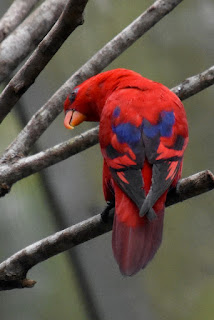As briefly mentioned in the earlier “Cairns” post, we took the train to Kuranda and back. The train itself is an attraction for those that like vintage trains. The alternative public transport is a bus, at less convenient times than the train, or the Skyrail Rainforest Cableway. Swaying in a gondola high above the trees is a nightmare to acrophobe Bill, so we took the train both ways.
The railway to Kuranda has been there for a long time, but we don't think the locomotive that took us into the hills was the original. Could be the same one that hauled the train Bill rode in 1971, though.
More traditional carriages
The journey was pleasant, through bush-clad hills with occasional views towards the coast. There was a brief halt at Barron Falls so we could all get out and take photos.
Barron Falls
For us, the big attractions in Kuranda itself are three places where (mostly) Australian wildlife can be seen up close.
Kuranda Koala Gardens
Despite the name, there is much more to see here than koalas. There are other species of marsupials, reptiles and amphibians.
Freshwater Crocodiles
A more alert Koala
A frog on the glass of its cage.
Birdworld Kuranda
A delightful place. It's a huge walk-through aviary so most of the birds can fly around you, and the visitor is allowed to pick up a bag of bird food and feed from the hand. Little difficulty here in getting within camera range of a colourful subject.
A male Eclectus Parrot. We doubt whether there is any other bird species where the males and females are so different.
Indian Ring-necked Parakeet, blue morph. Another attractive foreigner.
Bill's hat was not at all interesting. The same bird perched on his hand until it realised that Bill had no food to offer.
White-headed Pigeon
Even at the cafe, we encountered wildlife while eating our lunch.
This is an Australian Water Dragon. It's on a dry shed roof. Maybe it got lost?
Australian Butterfly Sanctuary
A quite different kind of delight. We have not yet sat down with a photograph of the identification board and tried to pin names on what we saw. We just gazed with great enjoyment.
Birdworld Again
We had enough time before our return train to nip quickly round Birdworld a second time.
Portrait of a Wandering Whistling-duck.
On the train ride back down to Cairns we photographed a different waterfall – the more eye-catching Stoney Creek Falls.






.jpeg)




.jpeg)


.jpeg)








.jpeg)







.jpeg)

.jpeg)




.jpeg)













